Scaffolding has been used for centuries and has become one of the most valuable and influential parts of the construction process. It allows for enhanced safety and security whilst allowing ease of access. Our article on the types of scaffolding and their uses will support you in your quest to determine which option is best for your property, whether it be commercial, domestic or industrial.
Different Types Of Scaffolding
From repairing warehouse roofing to building a new home from scratch, almost all construction work requires some form of scaffolding. The structure provides a safe, stable working platform for both construction workers and materials, helping to streamline the process.
If you have a project in the pipeline and have reached a stage where you need to consider hiring scaffolding, it may be tricky to know where to start. Our guide will go through the most common types and when they will be used, helping you to narrow down your options.
Get Started:
Most Common Types Of Scaffolding:
- Supported Scaffolding
- Suspended Scaffolding
- Double Scaffolding
- Cantilever Scaffolding
- Aerial Lifts
- Rolling Scaffolding
What Is Scaffolding?
In construction, scaffolding is a temporary structure built around a building or other structure to provide a safe working platform for construction workers. It helps them access different parts of the building at various heights, carry out tasks safely, and transport materials and tools efficiently during construction, maintenance, or renovation.
Scaffolding is an integral part of construction projects and serves several important purposes, the main being safety, accessibility and efficiency. Once a project is complete, the scaffolding is dismantled and removed, leaving the finished building or structure in place. For more information on what scaffolding is, its uses and typical cost, take a look at our previous article.
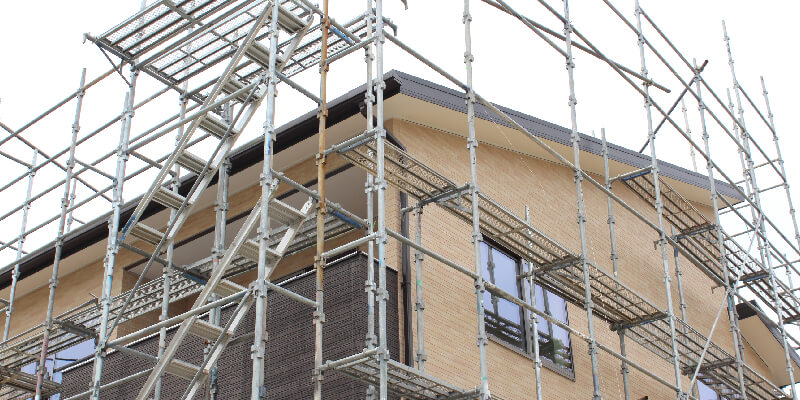
Supported Scaffolding
Supported scaffolding, also known as a brick layers scaffold, is generally used for brick masonry, making it the most commonly used type that the construction world has to offer; you would have seen it being used in construction work out and about in your daily life.
It is primarily used for elevation and is built from the base upwards to be used whenever needed, meaning it is the most accessible and most convenient type of scaffolding available. While also highly safe and secure, it is very cost-effective, making it an excellent choice for tradespeople.
Supported scaffolding typically comprises vertical and horizontal components, such as metal tubes and wooden planks, assembled in a specific configuration to create a stable and safe platform for workers. Consisting of standards, ledgers, putlogs etc., which are built parallel to the wall, usually at a distance of about 1.2m; ledgers are then connected to the standards at vertical intervals of about 1.2m to 1.5m; the putlogs are taken out from the hole left in the wall and connected to the ledgers.
In the UK, the use of scaffolding is regulated to ensure the safety of workers and the public. There are specific guidelines and regulations set by the Health and Safety Executive (HSE) that govern the design, erection, use, and dismantling of scaffolding to prevent accidents and ensure compliance with safety standards.
If you feel this type of scaffolding is right for you, contact our scaffolding company in Milton Keynes and Northampton for more information on our services!
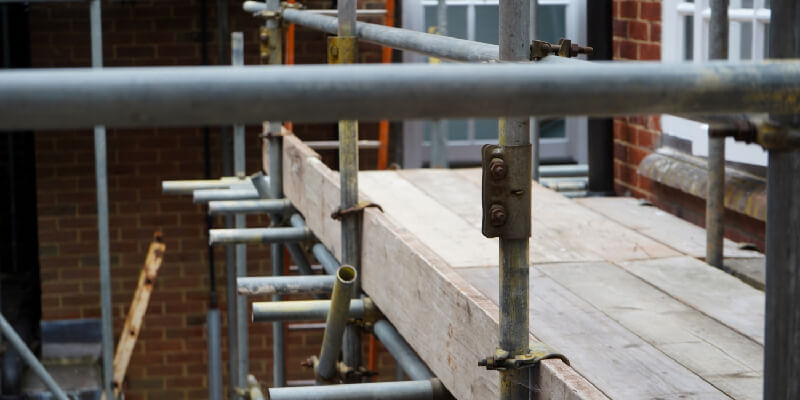
Suspended Scaffolding
The second main type of scaffolding is called suspended scaffolding. Unlike supported scaffolding, this involves the platform being suspended from the roof of a tall construct by a wire, rope or chain, as it is used when there is no possibility for a base or if higher levels will need to be accessed without building the scaffolding up from the ground to the level required.
It is designed with practical switches, levers and pulleys, which enable workers to access elevated areas that may be difficult or impossible to reach using other scaffolding types and lets users move up or down quickly. When noticing it in daily life, it may remind you of window cleaners who work on extremely high buildings, which is why the switches are handy.
There are many advantages and uses to suspended scaffolding, including:
- The platforms used in this type of scaffolding are incredibly lightweight and easy to assemble and disassemble
- The amount of materials required for greater heights is less with suspended scaffolding than with other types of scaffolding
- This type is easily portable and simple to store
- It is customisable and can be tailored to your required needs
However, suspended scaffolding also requires careful planning, proper installation, and adherence to safety regulations to ensure the safety of workers and the public. Workers using this type of scaffolding must be sufficiently trained and follow strict safety procedures to prevent accidents and falls. As with any scaffolding, regulations and guidelines regarding the use of suspended scaffolding may vary by location and can change over time, so it’s essential to check with local authorities and safety organisations for up-to-date information and compliance requirements.
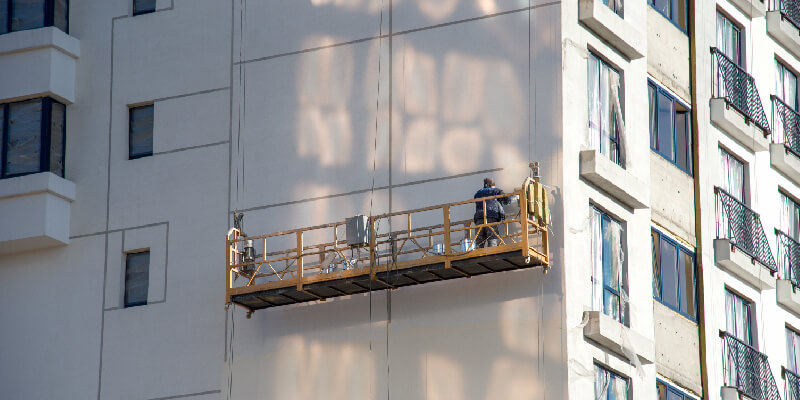
Double Scaffolding
This type of scaffolding is typically used for stone masonry and is also known as mason scaffolding for this reason. Double scaffolding is called “double” because it consists of two rows of vertical standards running parallel to the building’s wall, one inside and one outside. The inside row of standards is typically placed first at about 20 to 30cm away from the wall, and then the outside row is erected independently about 1 metre away from the wall.
Double scaffolding promises workers a multitude of benefits, such as the fact that the independent structure allows masons or workers to access the exterior walls without causing damage to the building’s structure. It is highly secure as there are multiple rows of scaffolding as well as putlogs, and it also does not require any holes to support the structure, which leads to less repair work and cleanup when the job is done.
For more information on our scaffolding in Milton Keynes, contact our team now!
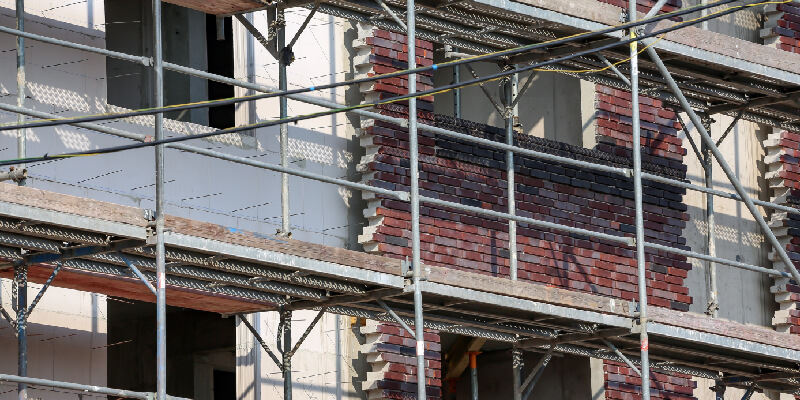
Cantilever Scaffolding
Cantilever or needle scaffolding is a specialised type of scaffolding, used when it is not feasible or safe to construct a traditional scaffolding structure from the ground up such as when there are obstacles on the ground or narrow pathways, preventing a regular system.
Key features of cantilever scaffolding include:
- Anchorage: Cantilever scaffolding relies on anchors or ties firmly attached to the building or structure to provide stability and support. These anchors are typically secured to the building’s framework or structural elements.
- Cantilever beam: A cantilever beam extends horizontally from the building’s edge, supported by the anchorage system. The beam acts as the main platform for workers to stand on while they perform their tasks.
- Counterweights or balancing system: To prevent the cantilever beam from tilting or becoming unstable, counterweights or a balancing system are often employed on the opposite side of the anchor points. These counterweights help maintain the equilibrium of the scaffolding.
These are pretty easy to build and are incredibly convenient for other situations, such as when the environment doesn’t have the capacity to support the scaffolding, when the floor near the wall needs to be free from traffic or when the upper part of the wall is under construction.
We recommend contacting our team for a reputable scaffolder in Milton Keynes to come out and assist you in deciding on which type of scaffolding to use based on your needs.
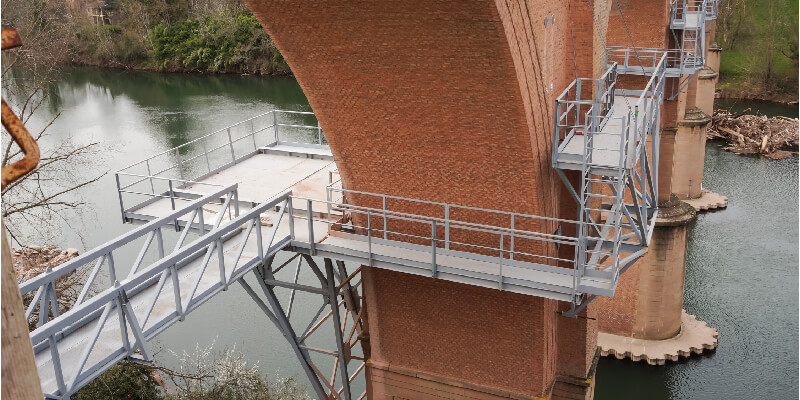
Aerial Lifts
Although not a traditional type of scaffolding, aerial lifts are nowadays classed as a type of mobile scaffold and are used in circumstances when workers need to access a number of levels to complete construction. For example, work on a multi-storey property where workers and materials are required on multiple levels throughout the day. This type of scaffolding makes lifting more considerable amounts of materials more accessible and safer.
Aerial lifts provide several advantages in construction, including increased worker safety, efficiency, and improved accessibility to elevated areas. However, proper training and adherence to safety guidelines are essential when operating aerial lifts to prevent accidents and ensure the well-being of workers.
Different types of aerial lofts can be tailored to your requirements, such as scissor lifts, aerial ladders and boom lifts. You should also keep in mind a few things when choosing the type of aerial lifts you want to use, such as:
- Weight capacity: Be sure you know the manufacturer’s weight limit for any lift you’re considering, as it needs to be safe for the number of people you are hoping to accommodate on one lift
- Load capacity: The lift should be able to support the amount of materials and heavy load you are planning to lift; not only does this mean weight but also size.
- Height and reach: The type of lift you choose can depend on the height and direction you need to reach, as some may give you better access to certain areas than others.
- Platform size: The shape and size of the platform can affect the centre of the lift’s gravity, meaning larger and wider platforms can usually carry less because they are heavier.
- Job site and conditions: Consider the environment you are working in, for example, whether you are inside, outside or in a large or narrow space.
For more information on aerial lifts, take a look at this article by Big Rentz.
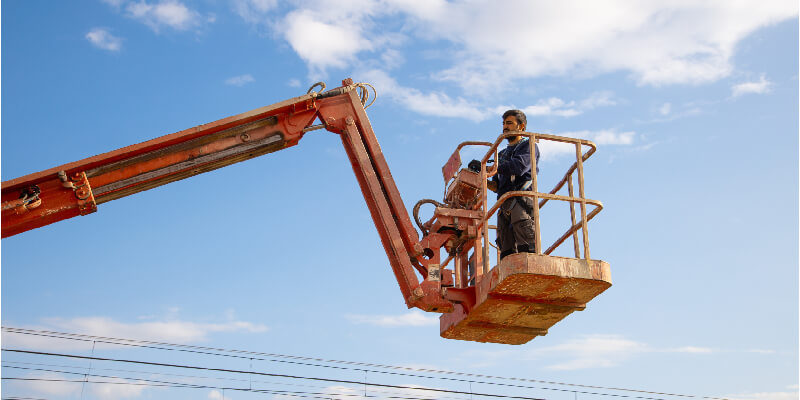
Rolling Scaffolding
Rolling scaffolding is a type of portable and versatile scaffolding system commonly used in construction, maintenance, and repair projects. Unlike traditional supported scaffolding that requires dismantling and reassembling at different locations, rolling scaffolding is equipped with uses castor-style wheels that offer stability whilst also functionality and mobility, which is very useful when completing work that requires going a distance and working over a length to allow for a more effective workplace. There are safety standards that are more necessary for rolling scaffolding than other types, for example:
- Remember to brace the scaffold with cross braces, horizontal braces, diagonal braces or a combination of all for extra stability
- Lock the scaffolds wheels in place with positive or swivel wheel locks when it is not being moved around to prevent any unwanted movement
- When moving the scaffold, ensure you apply manual force as close to the base as possible but no more than five feet above the supporting surface, as this will prevent any tipping
Contact our scaffolding company in Milton Keynes for additional queries or information!
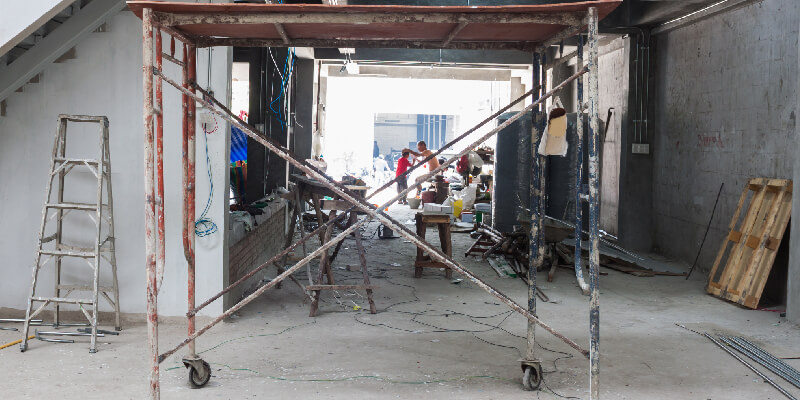
The Best Type Of Scaffolding For You
After providing all the information you need about scaffolding and its uses, you should be able to make an informed decision on the type that you believe fits you and your situation or requirements. For more help on your decision, take a look at our previous article on how much scaffolding costs.
Our advanced scaffolding company in Milton Keynes is guaranteed to offer you the best service possible to allow for an easy and smooth process, minimising any hassle or bother. Keep in mind; you can always contact our team of experts in scaffolding in Milton Keynes if you have any further questions, help or if you would like to book a free site survey.
